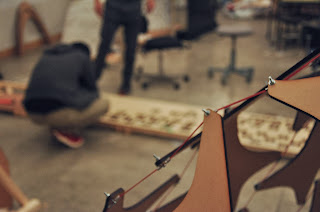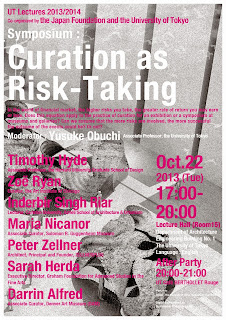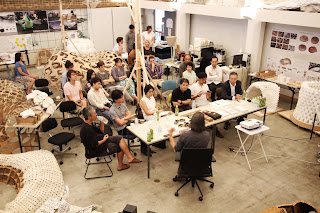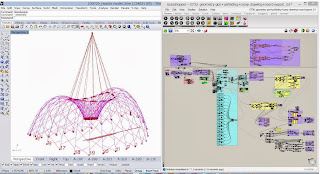Advanced Design Studies Blog: Critical Mass
Critical Mass Posts
1:3 mock-up of the G30 Summer Pavilion is on display at Architectural Institute of Japan(AIJ) for Archieering Design Exhibition 2013. This event was organized to connect architecture and structural engineering design. The mock-up will be exhibited until Nov. 22th.
With less than two weeks until the Obayashi company arrives on campus with crane to complete the final pavilion assembly, first year students have been focused and busy producing the various parts and pieces of the pavilion. The assembly of the tension cables finished last week, and attention has been shifted to laser-cutting the plywood pieces for the interior furniture elements, and hydro-inflating the stainless steel compressive components as they arrive from the fabricator in batches of 34, every two days.
 |
| Bolt insertion prior to crimping |
 |
| Laser-cut template for cable fabrication |
 |
| Team working outdoors on dual water inflation jigs |

|
| Hooking up the water line. |

In the world of financial market, the higher risks you take, the greater rate of return you may earn or lose. Does this equation apply to the practice of curation for an exhibition or a symposium at museums and galleries? Can we assume that the more risks are involved, the more successful the outcome of the events could be? Or not?
At the University of Tokyo’s Department of Architecture, 8 distinguished guests from the US and Canada are invited to participate in the symposium to discuss their personal experiences of risk-taking while curating exhibitions and/or projects.
Curation as Risk-Taking
October 22, 2013
17:00 – 21:00
Curation as Risk-Taking
October 22, 2013
17:00 – 21:00
Symposium at the University of Tokyo, Department of Architecture Coordinated by the Japan Foundation
The invited speakers are:
Timothy Hyde, Associate Professor, Harvard, GSD
Zoe Ryan, Curator, the Art Institute of Chicago
Inderbir Singh Riar, Lecturer, Carleton University
Mark Wasiuta, Adjunct Assistant Professsor, Columbia University
Maria Nicanor, Curator, Solomon R. Guggenheim
Peter Zellner, Architect, Principal, ZELLNERPLUS
Sarah Herda, Executive Director, Graham Foundation
Darrin Alfred, Curator, Denver Art Museum
Prof Obuchi and Toshi went to the fabrication shop in Toyohashi near Toyota Motor factory to review the progress on the fabrication process of our pavilion’s components. In collaboration with Tsukasa Takenaka of AnS Studio, the components have been developed in order to be fabricated by the Kuka’s robotic arm attached with a laser cutter and welder. Once welding is done, the component was inflated by a hydraulic pump.
2ndyear design teams are getting ready for their public presentation tomorrow. We have invited a wide range of professionals who shape the matters and information of Tokyo. Invited guests are:
Hiroo Mori,
Mori Building Co.
Yuko Hasegawa, Chief Curator
Museum of Contemporary Art Tokyo
Tomohiko Yamanashi, Executive Officer, Chief Architect, Design Section
Principal
nikken.jp
Takeo Igarashi, Professor
University of Tokyo, Graduate School of Information Science and Technology
http://www-ui.is.s.u-tokyo.ac.jp/~takeo/index.html
Takeshi Ito, Professor
University of Tokyo, Department of Architecture
Jun Sato, Associate Professor
University of Tokyo, Department of Architecture
4 design teams had their design thesis defense presentations. Each team was given 16 minutes to present their design proposal followed by a 6-minutes individual research presentation. All projects were reviewed by Kengo Kuma, Manabu Chiba, Yusuke Obuchi, joined by collaborative engineers: Jun Sato, Masayuki Mae, Futoshi Kurisu, and Ryoma Kitagaki.
We will have another presentation on Friday with invited guests form outside of the University of Tokyo.
Draft version of thesis project books are now uploaded on issuu:
http://issuu.com/obuchilab




















